|
LEE'S
NEW BOOK
Teaching
Amidst the
Neon Palm Trees
An exciting true story
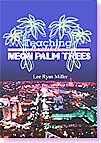
Intrigue and Corruption
in Las Vegas.
Click
Here
|
I chose to go on a safari in Tarangire National Park, hundreds of miles northwest of Dar. An 8 1/2 hour bus trip across the country enabled me to observe life in rural Tanzania.
The bus had no air conditioning. At the front of the bus, a digital display gave the temperature: 108 degrees. We drove through the streets of Dar es Salaam, past run-down buildings and sidewalks crowded with vendors selling everything from food to electronics. At one point we passed a billboard depicting a traditional African warrior talking on a cell phone—an interesting example of globalization.
We left the city on a well-paved two-lane highway. Our guide indicated that it had recently been paved with development aid from Japan. We passed through a flat grassy plain dotted with bushes and an occasional tree.
Now and then we passed some huts, sometimes all alone, sometimes clustered together. Some had mud walls, while others had no walls at all and were just poles supporting the roof made of palm fronds or grass, or occasionally, corrugated metal.
People tended farm animals and crops, some dressed in shorts and t-shirts, others wearing colorful robes. Few people wore shoes. Women often carried baskets on their heads. There were many bicycles, but hardly any cars. We saw no tractors or other farm machinery.
|
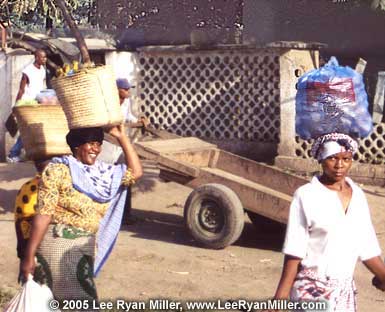
A
street scene in northern Tanzania.
|
My sinuses stung from the smoke-filled air. In the fields on both sides of the road were hundreds of small fires, set to clear away the brush for farming.
As we neared the city of Arusha, I could see the lone peak of Mt.
Kilamanjaro. The villages began to look somewhat more prosperous. Farms grew larger, and we began to see a few tractors. Houses were larger, no longer made of mud and grass. I noticed a few cars on the road, and that people were wearing shoes. Their clothing was Western for the most part, but nicer and more expensive than the dirty shorts and t-shirts I’d seen earlier.
Excerpt from a journal entry dated March 14, 2003
We spent the night in Arusha at the Impala Hotel. It was a beautiful hotel with all the modern amenities. My room was several times the size of my cabin on the ship. I took a quick shower and headed down for dinner.
There was a nice buffet for dinner. After dinner I went to the Internet café in the hotel to check my e-mail. Then I joined everyone else at the hotel bar. I got a beer and chatted with a group of five or six foreigners who were not part of our group. It turned out that they were all defense counsel for the UN tribunal for the Rwandan genocide. I had completely forgotten that the tribunal was located in
Arusha, Tanzania. When the lawyers found out that I was a political science professor, they invited me to bring the students to the tribunal and to attend a trial. I politely declined the offer, explaining that we were scheduled to depart Arusha early the next morning. But I promised to suggest to SAS that trips through Arusha in the future include a visit to the tribunal.
I found that I had to explain US policy toward Iraq to these lawyers (Europeans and Canadians). I found myself in the awkward position of having to explain why the Bush Administration is pushing for a second war against Iraq. I explained my own position that something should be done about Iraq, but that I oppose unilateral action by the US. The lawyers were very much against the Bush Administration policy.
|
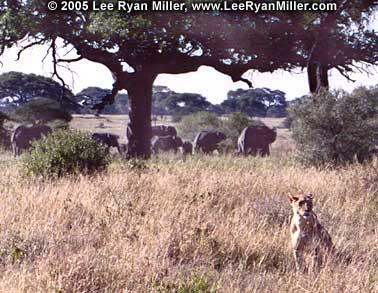
Lion Tarangire National Park,
Tanzania
|
I dragged myself away from this heated discussion sometime past midnight so that I could get some sleep. I was not very successful. I usually appreciate a firm bed. But this one was as hard as a rock. I kept waking up every few hours, sore on the downward-facing side, and had to flip over.
This was the first bed I’d slept in with mosquito netting. A fine mesh curtain hung over the bed. It was sort of like sleeping in a big bed in a sheer tent.
The next morning we boarded the safari vans. They were 8-passenger vans, the roofs of which can be raised so that passengers can stand up (in the shade of the raised roof) and get an unobstructed view of the wildlife. It seemed like most people had chosen to sit in a van with their friends. I located a van with an empty seat. In addition to the driver—a Tanzanian man named Sarakikiya (pronounced like Sarah-key-key), there were six young women.
We drove for two or three hours to Tarangire
National Park. We passed more farms. Often we saw villages composed of round mud huts with grass roofs. Men in red robes herded cattle. They were
Maasai, an ethnic group common in northern Tanzania and southern Kenya.
Just before we reached the park gate, we saw a couple of teenage boys dressed in black with their faces painted white. When we stopped at the park entrance for a bathroom break, I asked Cornelius, the safari director, about them. He explained that they were 14-year-olds who had recently be circumcised, according to Maasai custom. They dress in this fashion while they heal from the operation. Afterwards, they will be considered to be adult men; they will dress in red robes, braid their hair, and will be permitted to marry.
At the park gate we used the public bathrooms. The men’s bathroom had two rooms. One room had a sign indicating “urinals.” This square room had tiled walls. There was a six-inch wide, two-inch deep trench running along the floor at the base of 3 walls (all except for the wall containing the door). There were no urinals in this room. I gazed around for a few seconds and then figured it out. I unzipped my fly and peed on the tile. The urine ran down the wall into the depression on the floor and eventually made its way to the drain.
After the bathroom break, we boarded the safari vans and entered the park. There was a dramatic difference in landscape inside the park. Outside the landscape consisted of villages and farms, with few trees and no large animals. Inside the park was grassland dotted with trees and teeming with wildlife. There were no villages. The only people we saw were park employees and people on safari.
Excerpt from an article I wrote for Stanislaus
Connections
|
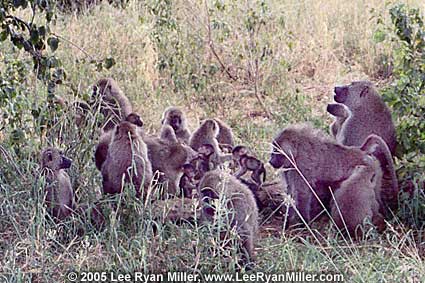
Troop of Baboons Tarangire National Park, Tanzania
|
Once inside the park, the landscape changed dramatically. The villages and farms disappeared, replaced by a grassland dotted with trees and teeming with wildlife, such as elephants, zebras, giraffes, gazelle, impala, baboons, and lions.
The park boundary provided a stark example of how environmental protection and poverty are often at loggerheads. The park preserved the natural flora and fauna. But the only native people inside were rangers or safari lodge workers. Outside the park, the animals had all been killed, and all the trees cut down to make room for farms.
Impoverished Tanzanian farmers, given the opportunity, would have cut down the remaining trees and killed and eaten the remaining game. How ironic it is that the last vestiges of Tanzania’s breathtaking natural environment have been preserved solely so that foreigners can go on safari. But such is the state of human misery: only when your belly is full, it appears, do you have the luxury of worrying about environmental protection.
Excerpt from a journal entry dated March 14, 2003
We drove for over an hour, snapping pictures of the animals. We saw herds of elephants, giraffes, and impala, as well as many other animals. We also marveled at the trees. There were baobab trees, with oversized trunks and undersized canopies of leaves. They looked as if someone had aggressively pruned these trees with ten or fifteen foot wide trunks. We also saw thorn trees and umbrella trees. These had slender, graceful trunks and branches. They also appeared to be pruned. They had no leaves except for high above the ground, and the tops of these trees were flat. Of course, no one had pruned them. This is just the way they grow.
The most bizarre tree of all was the sausage tree. There are fruits that hang from this tree that look just like big sausages (perhaps 2 inches by 18 inches).
We took lots of pictures of flora and fauna, and then headed to the Tarangire Sopa Lodge. My room was gargantuan. The bathroom alone was bigger than my cabin on the ship. After a nice buffet lunch, I took a nap and a swim in the pool. The pool was an interesting design. It was circular, with a large island in the center. You could walk across a bridge to get to the island.
In the late afternoon we went on a game drive. We saw more wildlife. It was amazing to be in a place where elephants were as common as crows back home. Around sunset, we returned to the lodge.
|
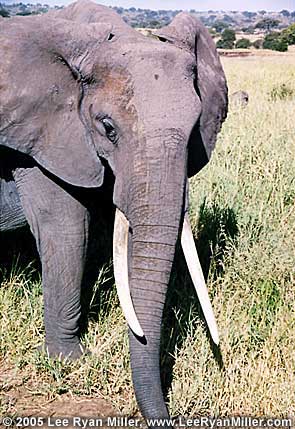
We
saw hundreds of elephants in
Tarangire National Park in Tanzania.
|
Instead of another buffet, waiters served us dinner. I chose to try a regional specialty. I can’t remember the name. It was made of beans and bananas. It tasted like, well, pinto beans in tomato sauce with chunks of bananas in it. Not bad.
I hung out in the bar talking to the students for a while and then got to bed by 11 p.m.
I woke up at 5:45. We departed at 6:30 for a game drive. The sunrise was beautiful. We stopped and saw a baobab tree silhouetted in orange. We saw lots more animals. One of the highlights was seeing two lionesses. They were crouching in the grass beside the road, near the safari vans. Our guide explained that they were hiding from the elephants nearby. Sure enough, once the herd of elephants passed, the lions got up and walked away.
We also saw many baby elephants, including a tiny one that could not have been more than four feet tall. It walked directly underneath its mother at all times. We also saw many other animals, including gazelle, impala, warthogs, giraffes, etc.
We returned to the lodge by 9:30 for breakfast. Afterwards, I took a nap and a swim in the pool. I had a leisurely day, and did some reading for my East Asian politics class. The free time on the bus ride up and during the day at the lodge enabled me to get ahead in my class preparations a bit. Good thing. Soon I expect to deluged with grading.
We went for another game drive from 3:00 to 7:00. We saw lots more animals, including a herd of zebra that trotted down to the riverside to munch on some green grass. We also saw a troop of baboons hanging out on and below a tree beside the road.
After dinner that night I hung out in the bar and chatted with some more of the students. I spoke with a guy named Joe. He was a liberal from Massachusetts who has interned for John Kerry, a senator currently seeking the presidential nomination of the Democratic Party. I also spoke with Laura, one of the young women on my safari van. She said she has been inspired by her experiences on Semester at Sea to choose a career in which she can help people.
|
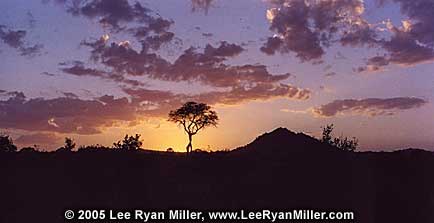
Sunrise,
Tarangire National Park, Tanzania
|
Then next morning we returned to
Arusha, boarded the buses, and headed back to Dar es Salaam. I was pleased that these buses had air conditioning. I did a lot more reading on the 12-hour bus ride back to Dar es Salaam.
The night I got back from safari I joined Pat (residence director) and Karen (field trips director) for dinner at the New Africa hotel restaurant. They each had been on previous SAS voyages, and told me fantastic stories. Each of them had a story about the ship breaking down. In one case, the ship was damaged when it ran aground due to the incompetence of Egyptian officials who were guiding it into harbor. The ship required major repairs; classes were cancelled, and everyone spent the last few weeks in Israel.
Another story involved the previous ship, the SS Universe. This ship broke down repeatedly on voyage, and finally it could go no further. It remained docked for a couple of weeks off Singapore. Faculty were told to finish their classes, and then students were given plane tickets and several weeks of free time to explore Asia on their own. Everyone eventually met in Hong Kong and flew home.
On the way out, a security guard struck up a conversation with me. Most people in Tanzania spoke Swahili, but this man’s English was quite good. We talked about quite a number of topics, and I found some of his comments quite interesting. For example, he stated that the American government is very rich. I asked him what he meant, and he explained that the US government had given a lot of aid to Tanzania, and that he was very appreciative.
One of our more amusing exchanges centered around marriage. “How much does it cost you to get married in the United States?” he asked me.
“It depends,” I explained. “If you just want to go to the courthouse and fill out the papers, it is quite cheap. But if you want a big wedding with hundreds of people, it will cost thousands of dollars.”
|
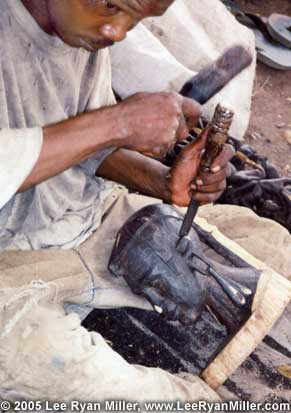
One
of the many artists I encountered
at the Mwenge market in
Dar es Salaam, Tanzania.
|
The man looked at me like I was from Mars. “No,” he said. “How much does it cost you to get married?”
Suddenly I realized what he was getting at. He was interested in the cost of dowries in my country. I explained that we do not have that custom in the US. The Tanzanian man was astonished.
The next day I headed into the city and went to an Internet café. It was located in a beauty parlor. Interesting combination. I had hoped to go to a reception at the local university, but the shuttle bus from the ship to the city center was so slow that I missed the bus. So I took a cab and went to the Mwenge market. I usually hate shopping, but I had to buy some souvenirs for people back home, and this gave me a good opportunity.
Bargaining is part of the culture in Dar. I bargained with the taxi driver. (He asked for $7, and I got him to agree to $5.) I bargained with the craftsmen at the market, who demanded that I pay them for taking photos. (They demanded $5 for one photo; I got 5 photos for $1). I bargained with the merchants in the stalls selling handicrafts. Here I don’t think I did as well. I got most things for about 1/3 less than the asking price. But after speaking with others, I found that several people got similar items for half what I paid. On the other hand, I got carved wood items and a painting for considerably less than what they would have cost in the US. So I suppose I did okay.
The merchants at the market would do anything to make a sale. At one point, I told a merchant that I only had the equivalent of 50 cents left, figuring that she would let me go. Instead, she sold me a tiny carved animal for that price. I learned my lesson. The next time a merchant approached me, I said that I had spent all my money. He responded by asking me if I would be interested in trading something. He suggested my camera or my sneakers. I imagined returning to the ship in my socks and laughed. “No thanks,” I responded.
 You may navigate the Semester At Sea section using the arrows.
You may navigate the Semester At Sea section using the arrows. 
|









